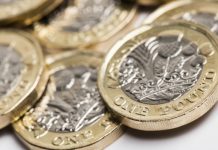The British pound (GBP) is flat against the US dollar (USD) on Friday morning.
GBP/USD was higher by 2 pips (+0.02%) at 1.3067 as of 10am GMT. The pound looks set to close the week close to where it began, rising a modest +0.11%.
There has been very little movement since Wednesday, with the currency pair oscillating in a small price range around 1.305.
GBP: UK tightens travel restrictions on France
Tightening travel restrictions were weighing on European markets Friday morning with the British pound little changed despite cause for some optimism that the UK is lifting the remainder of its lockdown restrictions.
From Saturday, bowling alleys, casinos, soft play centres and indoor concerts will reopen in the United Kingdom. At the same time, the British government has increased the fine for not wearing a facemask when required.
The UK added France, Malta and the Netherlands to its list of countries where visitors will be required to quarantine for 14 days. The UK is the largest source of tourists across Europe and the measures are a blow to the travel industry, which had been starting to recover. Authorities are attributing the highest number of cases in 3 months in Germany (1,200 cases) to returning travellers. France had 2,524 cases in 24 hours, the highest since it reopened from lockdown in May.
USD: Awaiting US retail sales data
The US dollar dropped on Thursday but finished well off its lows. Moreover the greenback has stabilised this week following a 5-week slump. There are some reasons the strength could be sustained; including haven flows amid a lack of agreement on a new US stimulus bill and souring US-Sino relations as well as some more upbeat US economic data.
Yesterday initial jobless claims dropped below 1 million for the first time since America went into nationwide lockdown. That follows much higher than expected consumer and producer inflation this week and a solid monthly jobs report.
US retail sales growth in July is expected to have moderated to 1.9% month-over-month from the 7.5% in June. The big jump in June was pent up demand from during lockdown conditions so the data is expected to show consumer behaviour normalise.





